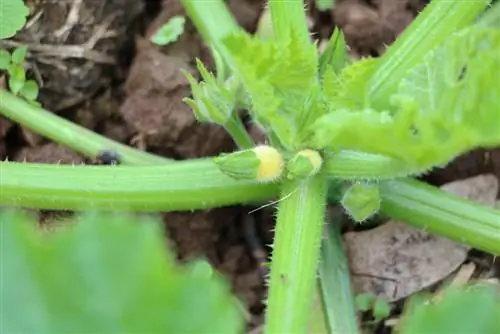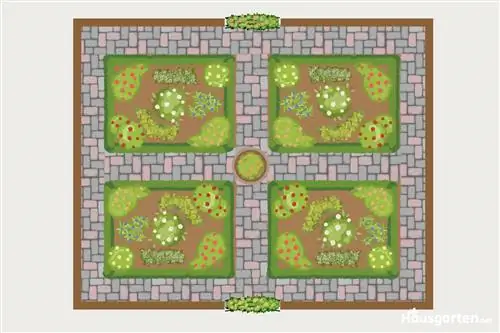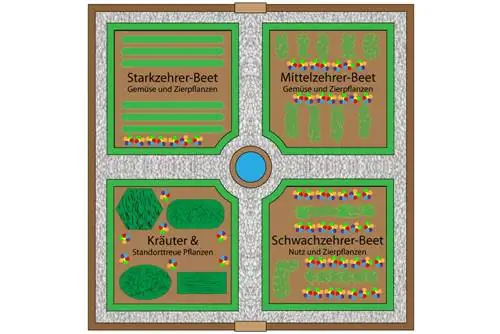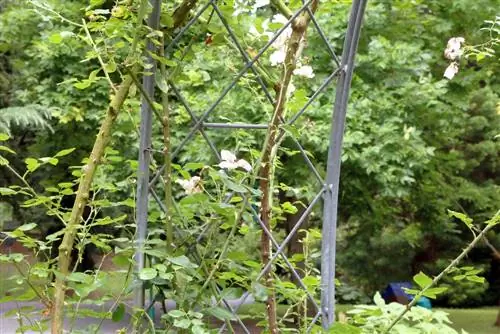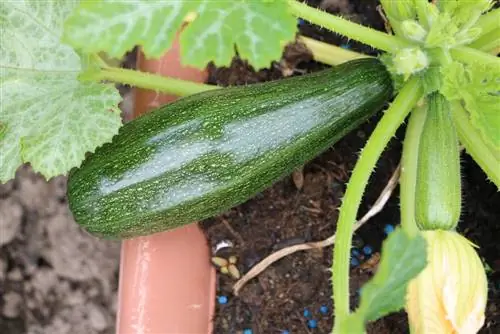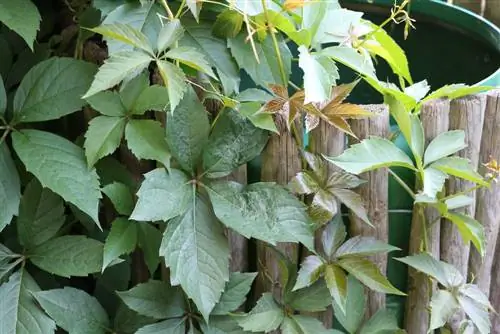- Author admin [email protected].
- Public 2023-12-17 03:39.
- Last modified 2025-06-01 06:48.
Climbing zucchini are ideal for space-saving vegetable cultivation - but they also require lots of nutrients and plenty of water. The effort required for care should therefore not be underestimated. Anyone interested can find out how it can be easier and which trellises are suitable, as well as everything worth knowing, from choosing a location to harvesting.
Location
Climbing zucchini thrive in sunny to partially shaded locations. It should be noted that, depending on the variety chosen, it can reach a height of up to two meters. There should therefore be enough space at the top. It is recommended to plant at least two climbing zucchini. This benefits the yield of both crops.
Tip:
For stabilization, it is recommended to be close to a wall or a robust and stable trellis.
Substrate
The substrate for climbing zucchini should be permeable, moderately water-retaining and nutrient-rich. Well suited as a base are:
- Garden soil
- Compost soil
- Planting soil
- Vegetable soil
To enrich with the required nutrients, well-rotted compost can be added, pre-fertilized soil can be used or a slow-release fertilizer can be mixed in.
Sowing
The climbing zucchini can be sown between April and June. Pre-germination indoors is possible as early as March. The following steps are important:
- Growing soil is used as the substrate, with which the seeds are only lightly covered.
- The substrate is kept slightly moist throughout.
- Germination occurs fastest if the planter is placed in a bright place at temperatures between 18 and 25 °C. For example, a window sill that is free of drafts is well suited.
- As soon as the young plants have four leaves, they can be repotted into the substrate described above and taken outside. However, only on frost-free, warm days. If cold snaps are to be expected at night, such as during the Ice Saints, the plants should be brought back into the house. Planting outdoors is possible as soon as the temperatures no longer fall below 10 to 15 °C, even at night.
Plants
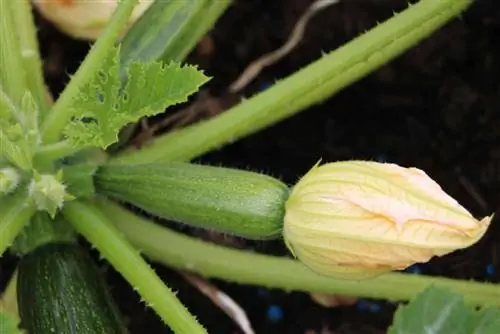
As an alternative to sowing your own, climbing zucchini can also be purchased as a young plant. Although these cost a little more, they also require significantly less effort. However, they also require protection from late frost. Planting outdoors should therefore not take place until the end of May or beginning of June. When grown in containers and with appropriate daytime temperatures, the plants can be placed outdoors and brought back indoors when the temperatures drop.
Pouring
The climbing zucchini, like its wide-growing relatives, grows very quickly and for this reason and because of the sunny location it needs plenty of water. Much of the liquid is also released through the large leaves. Watering must be done daily, especially in locations on the south side, with lots of hours of sunshine or high temperatures. In addition to using water that is as soft and low in lime as possible, it is important to water from below.
The leaves of the climbing zucchini should not be wetted when watering, as this quickly leads to burns and discoloration. The watering can is either placed just above the ground or a funnel can be used as a watering aid. Waterlogging should also be avoided with moisture-loving zucchini.
Fertilize
The climbing zucchini are heavy feeders and therefore require large amounts of nutrients. It is therefore important, on the one hand, to mix compost or fertilizer into the substrate when planting and, on the other hand, to repeat the fertilization if necessary. The second nutrient addition can wait two to three months when using compost or long-term fertilizer. It is important to water the plants well after this measure. This ensures an even distribution of nutrients and prevents chemical burns on the roots.
Trails
The climbing zucchini can - depending on the variety chosen - reach heights of between 60 and 200 centimeters. You therefore need appropriate climbing aids. Due to the large and sometimes heavy fruits, the climbing aids should be stable and robust. In addition to the nature, the accessibility of the plants is also important. The fruit-bearing shoots should be easily accessible from at least two sides. Otherwise, not only will harvesting become difficult, but ventilation of the shoots and leaves will also be restricted. This can in turn increase the risk of pest and disease infestation.
Depending on the location and planting outdoors or in containers, the following climbing aids may prove to be suitable:
Wireframe
Grids made of wire are inexpensive and can be bent and cut relatively easily - i.e. adapted to local conditions. However, stable variants should be chosen so that the heavy zucchini do not lead to unintentional deformation.
Ropes
Wire or rope - taut ropes can also be wonderfully adjusted. However, they are only suitable for locations that are at least partially covered, such as a balcony or terrace. To secure the shoots securely, three ropes should be used per plant.
Trellis
Made of wood or plastic, trellises are traditional climbing aids and are also suitable for climbing zucchini. However, plants and fruits are usually only accessible from one side. If you want to prevent this, you should direct the shoots to the back of the trellis early on. To do this, the shoots are carefully guided through the openings.
Staves
They are simple, easy to insert into the ground and allow free access to the zucchini from all sides. So that the sticks can serve as a stable climbing aid, at least two to three sticks made of robust plastic, bamboo or metal should be used per climbing zucchini.
Tip:
In addition to the type and material of the climbing aids, the attachment of the shoots is also important for climbing zucchini. Raffia, string, wire and also plant clips are suitable for this. Because even if the plant itself can hold on to the trellises or rods, the additional fixations provide protection and better support in wind and storms.
Bucket Culture
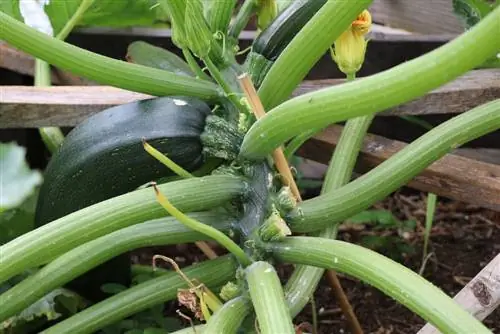
The climbing zucchini is also suitable for growing in containers. So it can even be grown on the balcony. However, with this type of culture there are a few points to pay attention to:
Volume
The planter should have a volume of at least ten liters. Smaller pots not only offer inadequate stability, but also significantly increase the maintenance effort. However, the larger the planter, the easier it is to supply.
Water
In a bucket, the climbing zucchini cannot supply itself with water as well as in the open field. This means it needs to be watered more frequently. On very hot days it may even be necessary to water in the morning and evening. At the same time, waterlogging must be urgently prevented. A shallow drainage layer or not using a planter can ensure this.
Fertilize
Since there is less substrate and therefore fewer nutrients available to the climbing zucchini in the pot, fertilization becomes more important when growing in a planter. Suitable means are small amounts of compost, pond water, plant manure and vegetable fertilizer, which are given once a month until harvest.
Blend
The annual climbing zucchini does not need any trimmings. The affected leaves and shoots should only be cut off if there is an infestation with pests or an infection by viruses or fungi. A sharp knife or scissors is used for this. The blades of the cutting tools are disinfected before and after use to prevent the transmission of pests or germs.
Bloom
The climbing zucchini produces flowers relatively quickly. The flowers can be female or male and are edible in either case. If you want to harvest them and use them in salads, stuff them, fry them or bake them, you should pay attention to the following points:
Male flowers
They will not produce fruit and have a simple stem without thickening. This makes the male flowers easy to recognize and can be harvested without any loss of yield.
Female flowers
Female flowers should remain on the plant as the fruits emerge from them. There is a clear thickening on the stem directly behind the flower.
Harvest time
In order for the female flowers to be fertilized, they need to be in close proximity to male flowers. The male flowers should therefore not be removed immediately as soon as the buds open. It is better to wait a few days so that the pollen can reach the pistils of the female flowers. If you don't want to do without fertilization by insects, you can do it yourself with a brush.
Harvest
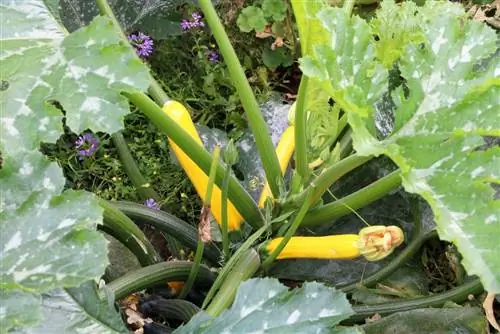
Harvesting the climbing zucchini can begin as soon as the fruits have reached an appropriate size. When this time comes depends on the species chosen. As a rule, a length of 15 to 25 centimeters should be achieved. If they become significantly longer and thicker, the following problems can occur:
- Fruits become dry and sometimes woody
- the risk of burst fruits increases
- the plant or shoots are burdened by the weight
It is therefore better to harvest gradually and not to leave the fruits on the climbing zucchini for too long. With optimal care and suitable weather, the harvest season can extend into autumn.
Typical diseases and pests
The zucchini is relatively resilient with appropriate care, but there is still a risk of pests and diseases. Typical are:
Snails
Snails mainly attack young plants and young shoots and can cause considerable damage to climbing zucchini. They should therefore be removed immediately if they are spotted. Slug pellets or slug traps can also be helpful.
Aphids
Aphids do not seem particularly threatening, but they can damage the climbing zucchini, lead to curled and deformed leaves and shoots and thus also affect the yield. If the pests themselves are noticed on the plant, a greasy black coating becomes visible or the deformations mentioned, appropriate countermeasures should be taken immediately.
This includes:
- the targeted release of ladybirds as natural predators
- spraying with commercial pesticides
- Spraying with nettle broth
Mildew
Mildew is noticeable through white spots and coatings on the leaves. It weakens the plant and can therefore have a negative impact on the yield. The following remedies and measures are effective:
- remove all severely affected leaves and shoots
- Use plant protection products against fungi
- Use a mixture of nine to ten parts fresh whole milk and one part water to spray the zucchini repeatedly
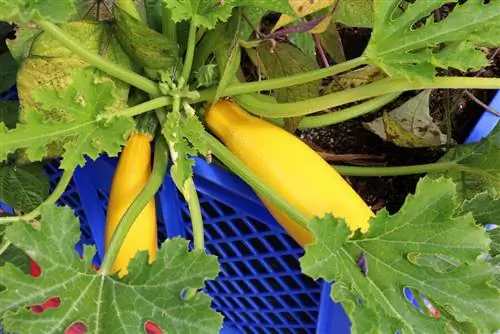
If you decide to use the solution of milk and water, it should leave on for half an hour and then be rinsed off with clear water. The application should be sprayed every three days until the mildew disappears.
Yellow mosaic virus
This viral infection presents with several symptoms. Below:
- yellow spots on the leaves
- weaker growth
- stunted leaves and shoots
- malformed fruits
Untreated, the yellow mosaic virus causes the plant to die. Prevention is possible by preventing or quickly eliminating an aphid infestation, as the pests can transmit the virus. Choosing resistant climbing zucchini varieties can also prevent the disease.
Typical care mistakes
Apart from frequent watering and coordinated fertilization, climbing zucchini is relatively easy to care for and resilient. However, errors in cultivation can cause the crop to become more susceptible to diseases and pests or to suffer significant damage more quickly if an infestation occurs. Proper care is also part of the preventive measures against infections and parasites. The following care mistakes in particular should be avoided:
- too little fluid intake
- Waterlogging due to lack of drainage or non-existent drain
- too low nutrient intake
- shady location
- no protection from frost
If there is reduced growth, discoloration or the plant even appears wilted, the conditions at the location and the culture should be checked accordingly.

